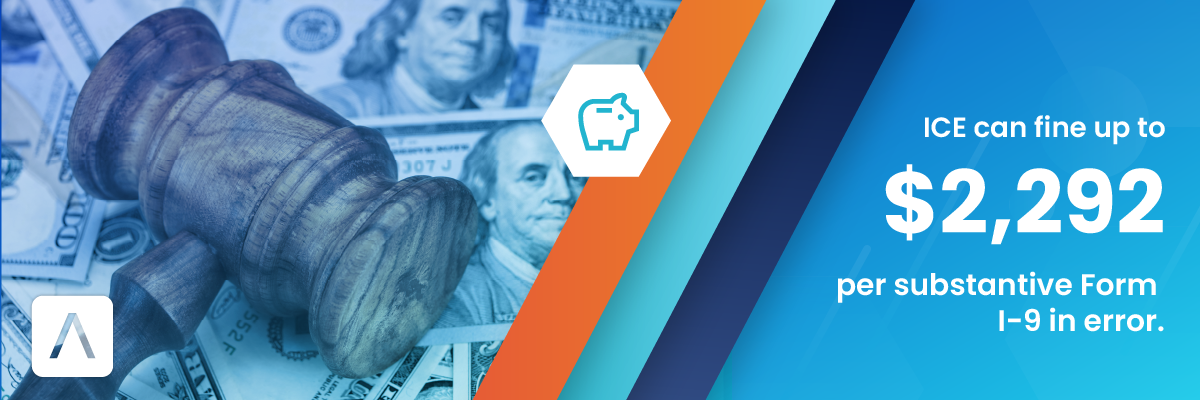If you’re an employer or HR professional, you’ve likely heard about this important aspect of hiring and onboarding. But what exactly is I-9 compliance? And why is it crucial for your business?
In a world where immigration laws constantly evolve, staying updated on employment eligibility verification regulations can be challenging. That’s where understanding I-9 compliance processes comes in handy. Mastering these procedures will ensure legal peace of mind and foster a positive work environment for all employees.
What is I-9 compliance?
What is I-9 compliance? In simple terms, I-9 compliance refers to verifying an employee’s eligibility for work in the United States.
The I-9 form plays a crucial role in this process for a variety of reasons. It requires the employer and the employee to provide specific, verified information and documentation to establish identity and employment authorization. The form must be completed within three days of an employee starting work, though all workplaces will have their own timelines in those three days.
To ensure proper I-9 compliance, it’s essential to understand the basics of the form itself.
- Section 1 focuses on personal information provided by the employee.
- Section 2 requires verification from the employer through the examination of supporting documents.
The I-9 process can seem daunting at first glance, but it becomes more manageable with careful attention to detail and an understanding of its requirements. Employers should familiarize themselves with acceptable documents for verification purposes. Failure to complete or retain forms accurately can result in penalties or legal troubles.
Understanding what I-9 compliance entails is essential for both employers and employees alike. By following proper procedures, avoiding common mistakes, and staying informed about any updates or changes in regulations, businesses can maintain a smooth and compliant hiring process while ensuring their workforce remains eligible for employment.
The basics of the I-9 form
The basics of the I-9 form are crucial for any employer in the United States – yet anyone who has worked with them will tell you that they are anything but basic.
The I-9 form consists of three sections. The first section requires the employee to provide personal information such as their name, address, and date of birth. They must also indicate their employment authorization status by checking one of several boxes provided.
This information should be easy to receive from the employee.
In the second section, employers are responsible for reviewing and verifying the documents presented by the employee as proof of identity and employment eligibility. These documents may include a U.S. passport, driver’s license, or social security card, just to name a few.
In the third section (if applicable), employers must update and re-verify certain information when an employee’s work authorization expires or if they are rehired within three years from previous completion. This isn’t something all employers will have to do, and even if they do have to do it, they will not do it regularly. If you don’t do it often, you could forget important parts and put yourself and your organization at risk.
Both employees and employers must complete this form accurately and timely to ensure compliance with immigration laws. Failure to do so can result in severe consequences, including fines or criminal charges.
Most Common Errors: Common errors made by employers when completing Form I-9 include missing information, incorrect dates, failure to sign and date the form, and not completing the form within the required time frame. It is important to carefully review and validate all information provided on the form to avoid potential issues.
The I-9 process
The I-9 process is crucial to ensure compliance with immigration laws and regulations. It involves verifying the identity and employment eligibility of all employees hired in the United States.
Let’s break down this process into its key components.
First, employers must provide new hires with the Form I-9 within three days of their start date. This form requires employees to provide specific documents that establish their identity and work authorization, such as a passport or driver’s license and Social Security card.
Once the employee has completed Section 1 of the form, it is up to the employer to examine and verify the authenticity of these documents by completing Section 2. Employers must ensure they review original documents — photocopies or faxes are unacceptable. This is more challenging for remote workers, so HR should give themselves ample times.
Employers must remember that they cannot specify which specific documents an employee may present from the list provided on Form I-9. Any document is to be accepted, as long as an employee gives valid documentation from List A (establishing both identity and work authorization) or a combination of List B (identity) and List C (work authorization), they have met their obligation under this process.
After reviewing and verifying these documents, employers must accurately record pertinent information in Section 2 of the Form I-9. Mistakes made during this step can result in penalties if discovered during an audit conducted by Immigrations Customs Enforcement (ICE).
Employers should also remember that retaining completed Forms I-9 is necessary for maintaining compliance. These forms should be kept separate from personnel files but readily accessible for inspection if required by government agencies. It is also important to keep these documents secure – employee data that gets stolen can cause major issues.
Avoiding common mistakes in I-9 compliance
When it comes to I-9 compliance, making mistakes can be costly. Non-compliance with the Immigration and Nationality Act (INA) regulations can result in hefty fines and penalties for businesses.
One common mistake is failing to properly complete Section 1 of the I-9 form. Employees must provide their full legal name, date of birth, address, and other required information. Incomplete or inaccurate data can lead to discrepancies that may raise red flags during an audit.
Another pitfall is accepting invalid documents as proof of identity or work authorization. It’s essential to familiarize yourself with acceptable forms of identification outlined by U.S. Citizenship and Immigration Services (USCIS). Accepting expired documents or those not listed on Form I-9 could land you in trouble.
Additionally, employers sometimes forget about re-verifying employment eligibility when necessary. If an employee’s work authorization expires, follow up before it lapses to maintain compliance. If you tend to forget things like this, I-9 verification software can help remind you.
Furthermore, improper storage and retention of I-9 forms can also lead to issues years after an employee is hired. These forms should be kept separate from personnel files and stored securely for at least three years after hire or one year after termination – whichever is later.
Neglecting regular self-audits increases your chances of non-compliance discovery during external audits. By conducting internal reviews periodically, you can identify potential errors early on and take corrective action promptly.

A great I-9 process is required for all organizations
Understanding and navigating the intricacies of I-9 compliance processes is essential for any organization that employs workers in the United States. By familiarizing yourself with the basics of the I-9 form and implementing a thorough and systematic approach to the I-9 process, you can ensure that your company remains compliant with federal regulations.
By prioritizing proper training for HR staff involved in completing Form I-9s, conducting regular internal audits, and establishing clear procedures for record retention, you can minimize risk and maintain a culture of compliance within your organization.
Tracker I-9 is a user-friendly software that simplifies the Form I-9 process, reduces compliance risks, and offers features such as electronic storage, automated updates, and robust data security. With its intuitive interface and dedicated customer support, Tracker I-9 is an ideal choice for organizations seeking efficient and reliable Form I-9 management. To learn more, request a demo today.




